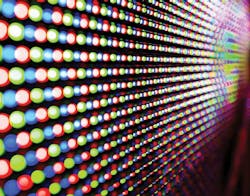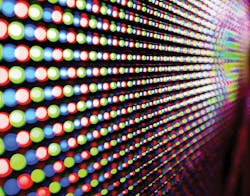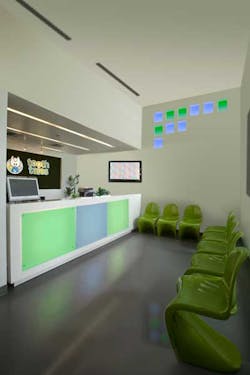The recent Lightfair International trade show held in Philadelphia in April confirmed that LED technology continues to bring sweeping changes to the electrical industry. As LED chips become smaller and increase in efficiency levels, fewer dies are needed in a single fixture. At the same time, the near point size of the source allows for smaller, more efficient optics. Manufacturers are also working on the driver module, which works similar to a fluorescent ballast in controlling voltage and current, to make sure its longevity matches that of the LED source. Let’s take a look at some of the significant trends I identified from this year’s show that support growth in the LED market sector and suggest what’s in store for the future of lighting.
Trend #1: Accent on color
Lighting’s new frontier appears to be the ability of the LED chips to deliver the exact color and luminance level desired by an occupant with more simplified control systems. A number of innovative control solutions evidenced at the show centered on the ability to fine-tune the light output to get an exact shade of white light from warm to cool (the color tunability and the dim-to-warm color shift mentioned above) and from red to blue saturated colors.
In the past, manufacturers prioritized high lumen output over producing warmer colors. First- and second-generation LED lamps and fixtures generally operated at cooler color temperatures (5,000K to 6,500K), but this is changing. Vendors showed numerous LED sources in the warmer color temperature range of 3,000K and 2,700K. Additionally, an LED downlight can now duplicate the way an incandescent or halogen lamp will dim to a very warm color temperature as the power (voltage level) is reduced. The phrase “tunable” white lighting (which means that a user can select a specific color temperature of the light produced) — a subject discussed more than a year ago — is now a reality.
One manufacturer at Lightfair displayed two different types of white-point dimming:
1) Warm glow dimming focuses on ambiance and mimics the black-body curve of an incandescent lamp, changing from 2,700K or 3,000K at full power to 2,200K at low light levels.
2) Color curve dimming provides white 3,500K light at full power while warming to 2,200K when totally dimmed.
In addition to downlighting applications, this concept is also found in a linear luminaire that can be recessed into walls or ceilings for wall-wash, wall-graze, and direct applications.
Closely associated with tunable white lighting technology is dynamic color-tuning lighting — the ability to alter the color of light to imitate the natural variations of sunlight throughout the day and sync to circadian rhythms, using RGB LEDs.
Trend #2: Consider lighting and control inseparable
Lighting controls are an important component of an energy-efficient building. LED lighting can be controlled in a number of simplified ways to help slash energy usage, enhance lumen maintenance and code compliance, and achieve adaptive control schemes. This means that an individual space can look exactly as you want it. This is possible because the LED source is essentially a semiconductor “chip” that gets its power from a driver circuit. Adding a microcontroller or a network communications interface circuit to the driver of an LED lighting system creates a versatile control/switching system.
While a convergence of technology is happening in energy management controls, the dimming of solid-state light sources has been an ongoing problem. Contractors and/or end-users face the issue of control compatibility between the source and the control method. Nevertheless, Lightfair revealed that digital lighting control for LED luminaires is becoming more widespread — moving from an add-on system to being integral to today’s luminaires — using a wired or wireless control network, a hybrid of the two, or a power-line control scheme. Manufacturers showed off third-party controls, and many booths had LCDs displaying software screens with lighting control graphics and the ability of a cellular phone connection to provide control functions. Clearly, the future of lighting controls will not be limited to occupancy or daylight harvesting functions.
In general, lighting control network systems of any appreciable size have been proprietary. Although work on a standards-based network protocol is ongoing, one or more required layers of a full OSI network stack in the seven-layer OSI model are missing, usually the top layer (the application layer). Fortunately, a number of open standards are emerging in specific control application areas, such as the wireless lighting control portion of the commercial lighting market, and this technology has become more reliable and affordable over the past 10 years.
Two wireless communications standards emerged at Lightfair as standouts: the ZigBee Commercial Building Automation standard — part of the ZigBee Alliance — and the EnOcean Alliance. The ZigBee Alliance recently created two new standards to serve lighting applications: LightLink and ZigBee IP. Based on the IEEE 802.15.4 standard for personal area networks, ZigBee uses the 2.4-GHz band and adds extra layers to the protocol to implement a 2-way, wireless mesh network that can be integrated into a wired BACnet system. The protocol recently grew to include a ZigBee PRO Green Power feature, which allows devices to be powered by energy-harvesting methods rather than by batteries or AC power. Although ZigBee doesn’t inherently support the Internet Protocol (IP) used in the Internet and Ethernet networks, an alternative IP-based protocol called 6LoWPAN (IPv6 over Low power Wireless Personal Area Network) is gaining momentum. One concern is that the 2.4-GHz frequency band is congested with traffic from WLAN, Bluetooth, and other wireless products, such as microphones, cameras, and cell phones.
The EnOcean Alliance wireless control standard uses self-powered sensors and control product developed by EnOcean GmbH. These bidirectional communications devices, using a license-free 902-MHz frequency with a range of more than 100 ft, are powered by slight changes in ambient conditions, such as temperature or humidity, ambient sunlight, and the manual operation of a rocker switch — not by batteries. Because the communications involves sending measured data packets and control commands of limited size, the messages can be funneled back to a monitoring station or shared with other devices using a structured wiring system, where higher bandwidths are available.
The self-powering technology continues to mature. At a recent technical expo, an EnOcean Alliance partner showed a new type of dye-sensitized solar cell (DSC) that closely resembles the plant photosynthesis processes, using a manufacturing process based on printing technology to create the cell surface. These new solar cells can be used on walls with little sun exposure indoors and in other environments where solar power generation was not possible before.
A number of vendors at Lightfair also showed short-range wireless lighting control products using Wi-Fi-based communications. Communicating wirelessly among fixtures with sensor and chip-based circuits permits daylight harvesting, bi-level control, and a wide choice in power switching. Although commissioning and up-front cost issues remain, control companies are bringing down the price of both wired and wireless systems and making them easier to use, including support on popular devices such as smart phones and tablets.
Trend #3: Wireless control for outdoor lighting
Outdoor and street lighting LED luminaires that use a wireless communications system to monitor and control the luminaire is a market that should continue to grow dramatically. Because street lighting can account for up to 40% of the total electricity costs for a municipality, this group will find keen interest in this development. A networked control system can provide an additional 30% reduction because a monitoring program can pinpoint electrical power problems, such as ground faults and burned-out lights, eliminating the need for night-time monitoring patrols. Such a network consists of field devices — the luminaires, sensors (such as a watt-hour meter or motion detector) and a wired or wireless communications system — that connect to a network infrastructure (server/database) and finally to a central management system.
In the past, a variety of proprietary wireless communications-based monitoring and control systems dominated this market. However, a new industry group, called the TALQ Consortium, is developing a software protocol specification for the applications layer in the OSI network model to link a central management system with a street lighting system’s network communications system. Ratified in August 2013, this standard is a step forward because municipalities and electric utilities will no longer have to fear supplier lock-in if they specify TALQ-certified outdoor lighting systems. Another important development is the recent release of the DOE’s Municipal Solid-State Street Lighting Consortium Model Specification for Adaptive Control and Remote Monitoring of LED Roadway Luminaires.
A renovation project completed in 2012 shows the value of a networked outdoor lighting control system. To lower the state’s energy usage, the California Public Utilities Commission (CPUC) has called for a 60% to 80% reduction in electrical lighting consumption statewide by 2020.
Answering the call in 2010, the University of California-Davis (UC Davis) established its Smart Lighting Initiative to renovate existing indoor and outdoor campus lighting. Dubbed the Adaptive Campus Control system, it integrates more than 1,660 individually addressed dimmable LED pole-mounted and wallpack fixtures into an advanced wireless lighting control network. The central communications server permits the adjustment of fixture operation, preset times, and dimming schedules. For example, sensors are triggered when a cyclist, pedestrian, or vehicle approaches an area — individual fixtures in the vicinity respond. Sensor data is also shared, so the system can predict the occupants’ path of travel and raise light levels to full output ahead of them. Light levels then return to the default setting (low mode) after an adjustable time period elapses with no further motion detected. Costs for the project were partially offset by an electric utility rebate based on annual kilowatt-hours saved.
Trend #4: Supplementing AC power in a building with DC power
A movement to use a 24VDC power distribution system within a building along with the AC power system (to avoid unnecessary transformations between AC and DC power) is gaining interest with the backing of an industry association called the EMerge Alliance. A number of vendors displayed LED luminaires at Lightfair that work directly from a 24VDC power system because the design of a driver module can be simplified — it does not require an AC/DC power supply with an electrolytic capacitor — a major point of failure in such a circuit. They also noted that other building service appliances, such as HVAC actuators, motor loads, pumps, etc., use DC power, making the availability of DC power a key component in the quest for a zero net-energy building.
The initial concept was to provide DC power distribution for interior occupied space applications in a commercial office building, with lighting being an important application. But now, the Alliance envisions the deployment of a DC microgrid within a building or campus environment. A microgrid is an electric power distribution system containing loads and distributed energy resources (such as distributed generators, fuel cells, renewables, energy storage devices, and/or controllable loads) that can be operated in a controlled, coordinated way — either while connected to or disconnected from the main power network. Considered by many experts to represent the ideal building blocks of a far more resilient and efficient Smart Grid, a DC microgrid should be able to couple multiple sources of power without complex frequency synchronization and economically integrate DC power sources with DC loads.
Trend #5: Promoting modular-type LED luminaires
A typical LED luminaire consists of individual components, such as a heat sink to transfer heat away from the LED chip, reflectors, an optical system, and a power supply called a driver. These components are continuously being redesigned and improved — often at a six- or 12-month cycle. Ideally, a luminaire body should be able to be used for many years, and the light source or a driver/other components should be fully interchangeable. But the reality is that some products are designed around parts that are replaceable, but only with major disassembly. Increasingly, luminaires with replaceable components are coming into the market, but the connections may be proprietary or have other shortcomings.
A three-year-old industry association called the Zhaga Consortium, an alliance of more than 180 companies, seeks to provide interchangeability of LED light sources made by different manufacturers. The association is working on specifications for mechanical, photometric, thermal, and electronic compatibility of LED modules and systems.
About the Author
Joseph R. Knisley
Lighting Consultant
Joe earned a BA degree from Queens College and trained as an electronics technician in the U.S. Navy. He is a member of the IEEE Communications Society, Building Industry Consulting Service International (BICSI), and IESNA. Joe worked on the editorial staff of Electrical Wholesaling magazine before joining EC&M in 1969. He received the Jesse H. Neal Award for Editorial Excellence in 1966 and 1968. He currently serves as the group's resident expert on the topics of voice/video/data communications technology and lighting.


